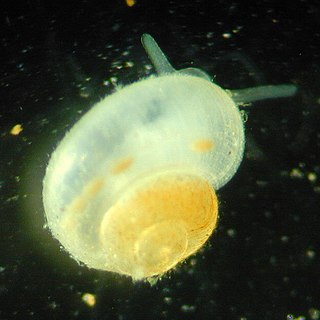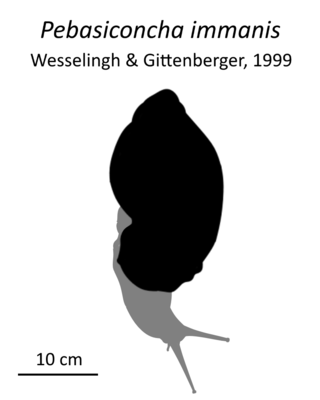The Peba–Yaguan language family is located in the northwestern Amazon, but today Yagua is the only remaining spoken language of the family.

The nine species in the genus Philander, commonly known as gray and black four-eyed opossums, are members of the order Didelphimorphia. Mature females have a well-developed marsupium. The tail appears to be hairless except for the proximal 5 or 6 cm, which has a few long hairs. The tail is slightly longer than the head-and-body length, and it is black for the proximal one half to two thirds of its length. The genus is closely related to Didelphis but the species of Philander are smaller than those of Didelphis. The genus formerly included Metachirus nudicaudatus, but this species lacks a pouch and so is now considered a separate genus. The common name comes from the white spots above the eyes, which can appear from a distance to be another set of eyes.

Stupendemys is an extinct genus of freshwater side-necked turtle, belonging to the family Podocnemididae. It is the largest freshwater turtle known to have existed, with a carapace over 2 meters long. Its fossils have been found in northern South America, in rocks dating from the Middle Miocene to the very start of the Pliocene, about 13 to 5 million years ago. Male specimens are known to have possessed bony horns growing from the front edges of the shell and the discovery of the fossil of a young adult shows that the carapace of these turtles flattens with age. A fossil skull described in 2021 indicates that Stupendemys was a generalist feeder.
Polyether block amide or PEBA is a thermoplastic elastomer (TPE). It is known under the tradename of PEBAX® (Arkema) and VESTAMID® E. It is a block copolymer obtained by polycondensation of a carboxylic acid polyamide with an alcohol termination polyether, PEG). The general chemical structure is:

Melongena is a genus of sea snails, marine gastropod mollusks in the family Melongenidae, the crown conches and their allies.

The Didelphinae are a subfamily of opossums consisting of 15 genera and 123 species. Specimens have been collected throughout the Americas, but are predominant in South and Central America.

The Mariscal Ramón Castilla Province is one of the eight provinces in the Loreto Region of Peru. It was created by Law No. 22728 on October 18, 1979 by President Francisco Morales Bermúdez. The province was named after Ramón Castilla.
Parapropalaehoplophorus septentrionalis was a comparatively small species of glyptodont, extinct relatives of the modern armadillo. The mammal, identified in 2007 from the fossilized remains of a specimen found in 2004, weighed approximately 200 pounds and had a shell covered by tiny circular bumps. It lumbered around northern Chile in the Chucal Formation, an area now dominated by the Andes mountain range, some 18 million years ago. Fossils of the glyptodont also have been found in Peru.
Pebas District is one of four districts of the province Mariscal Ramón Castilla in Peru. Its name is derived from Peba, an indigenous ethnic group and language.
Saparo–Yawan is a language family proposal uniting two small language families of the western Amazon. It was first proposed by Swadesh (1954), and continues through Payne (1984) and Kaufman (1994).

Cochliopidae is a family of small freshwater snails with gills and an operculum, aquatic gastropod mollusks.
Sagittala is a genus of moths of the family Notodontidae. It consists of only one species, Sagittala peba, which is found in Panama and Costa Rica.
Onobops is a genus of very small aquatic snails, operculate gastropod mollusks in the family Cochliopidae or in the Hydrobiidae.

Pebasiconcha immanis is an extinct species of air-breathing land snail, a terrestrial pulmonate gastropod mollusk in the family Acavidae. The type locality of Pebasiconcha immanis is the Miocene Pebas Formation in the Colombian and Peruvian Amazonia.

Caiman wannlangstoni is an extinct species of caiman that lived in what is now the Amazon Basin and surrounding areas during the Middle and Late Miocene. Fossils of C. wannlangstoni have been found in the Pebas Formation near Iquitos in Peru and include partial skulls and isolated skull bones. Other fossils were uncovered from the Urumaco Formation in Venezuela and the Laventan Honda Group of Colombia. The species was first described in 2015. Features that in combination distinguish C. wannlangstoni from other caimans include a deep snout, a wavy upper jaw margin, a large and upward-directed narial opening, and blunt teeth at the back of the jaws. Based on the sizes of the skulls, its estimated body length is about 211 to 227 centimetres.

Kuttanacaiman is a monotypic genus of extinct caiman represented by the type species Kuttanacaiman iquitosensis. Kuttanacaiman lived in what is now the Amazon basin during the Middle Miocene, approximately 13 million years ago (Ma). The species was named in 2015 on the basis of one nearly complete skull and a second partial skull from the Pebas Formation near Iquitos, Peru. K. iquitosensis is characterized by a short, rounded snout and blunt teeth at the back of its jaws that were likely adapted to crushing freshwater bivalves. Its estimated total body length is 171.2 to 189.1 centimetres.

Gnatusuchus is an extinct genus of caiman represented by the type species Gnatusuchus pebasensis from the Middle Miocene Pebas Formation of Peru. Gnatusuchus lived about 13 million years ago (Ma) in a large wetland system called the Pebas mega-wetlands that covered over one million square kilometers of what is now the Amazon Basin.
Paradracaena is an extinct genus of lizards from northern South America. Fossils of Paradracaena colombiana have been found in the Honda Group of Colombia, Peru and Brazil. The species was described as a member of the tegus; Tupinambis huilensis by Estes in 1961.

Pseudoprepotherium is an extinct genus of sloths of the family Mylodontidae. It was widespread across northern South America during the Early to Late Miocene epoch around 21 to 5.3 million years ago. Fossils of the animal have been found in Brazil, Venezuela, and Peru. Pseudoprepotherium lived in a tropical climate with a water-rich environment. Their known remains are limited to limb bones, except for a few skulls and teeth. Based on these remains, they were most likely medium to large-sized mylodontid. The genus was described in 1961 and currently contains three species, which were originally assigned to the genus Prepotherium.









